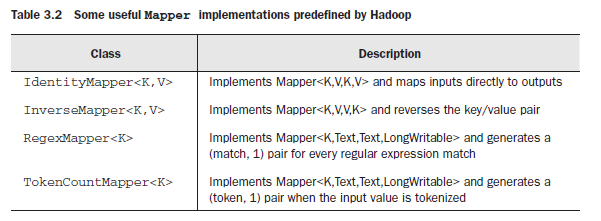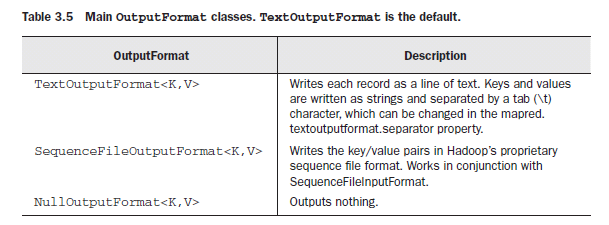| <1>.
WordCount示例及MapReduce程序框架
首先通过一个简单的程序来实际运行一个MapReduce程序,然后通过这个程序我们来哦那个结一下MapReduce编程模型。
下载源程序:/Files/xuqiang/WordCount.rar,将该程序打包成wordcount.jar下面的命令,随便写一个文本文件,这里是WordCountMrtrial,并上传到hdfs上,这里的路径是/tmp/WordCountMrtrial,运行下面的命令:
xuqiang@ubuntu:~/hadoop/src/hadoop-0.21.0$
./bin/hadoop jar wordcount.jar WordCount /tmp/WordCountMrtrial
/tmp/result
如果该任务运行完成之后,将在hdfs的/tmp/result目录下生成类似于这样的结果:
gentleman 11
get 12
give 8
go 6
good 9
government 16
运行一个程序的基本上就是这样一个过程,我们来看看具体程序:
main函数中首先生成一个Job对象, Job job = new Job(conf,
"word count");然后设置job的MapperClass,ReducerClass,设置输入文件路径FileInputFormat.addInputPath(job,
new Path(otherArgs[0]));设置输出文件路径:FileOutputFormat.setOutputPath(job,
new Path(otherArgs[1]));等待程序运行完成:System.exit(job.waitForCompletion(true)
? 0 : 1);可以看出main中仅仅是启动了一个job,然后设置该job相关的参数,具体实现MapReduce是mapper类和reducer类。
TokenizerMapper类中map函数将一行分割成<K2,
V2>,然后IntSumReducer的reduce将<K2, list<V2>>转换成最终结果<K3,
V3>。

通过这个示例基本上也能总结出简单的MapReduce编程的模型:一个Mapper类,一个Reducer类,一个Driver类。

<2>. MapReduce程序执行流程
这里所描述的执行流程更加注重是从程序的角度去理解,更加全面的流程可参考[这里]。

首先用户指定待处理的文件,在WordCount就是文件WordCountMrtrial,这是hadoop根据设定的InputDataFormat来将输入文件分割成一个record(key/value对),然后将这些record传递给map函数,在WordCount示例中,对应的record就是<line_number行号,
line_content该行内容>;
然后map函数根据输入的record,形成<K2, V2>,在WordCount示例中形成<K2,
V2>就是<single_word, word_count>,例如<"a",
1>;
如果map过程完成之后,hadoop将这些生成的<K2, V2>按照K2进行分组,形成<K2,list(V2)
>,之后传递给reduce函数,在该函数中最终得到程序的输出结果<K3, V3>。
<3>. 深入学习MapReduce编程(1)
3.1 hadoop data types
由于在hadoop需要将key/value对序列化,然后通过网络network发送到集群中的其他机器上,所以说hadoop中的类型需要能够序列化。
具体而言,自定义的类型,如果一个类class实现了Writable interface的话,那么这个可以作为value类型,如果一个class实现了WritableComparable<T>
interface的话,那么这个class可以作为value类型或者是key类型。
hadoop本身已经实现了一些预定义的类型predefined classes,并且这些类型实现了WritableComparable<T>接口。

3.2 Mapper
如果一个类想要成为一个mapper,那么该类需要实现Mapper接口,同时继承自MapReduceBase。在MapReduceBase类中,两个方法是特别需要注意的:
void configure( JobConf job):这个方法是在任务被运行之前调用
void close():在任务运行完成之后调用
剩下的工作就是编写map方法,原型如下:
void map(Object key, Text value, Context
context
) throws IOException, InterruptedException;
这个方法根据<K1, V1>生成<K2, V2>,然后通过context输出。
同样的在hadoop中预先定义了如下的Mapper:

3.3 Reducer
如果一个类想要成为Reducer的话,需要首先实现Reducer接口,然后需要继承自MapReduceBase。
当reducer接收从mapper传递而来的key/value对,然后根据key来排序,分组,最终生成<K2,
list<V2>> ,然后reducer根据<K2, list<V2>>生成<K3,
V3>.
同样在hadoop中预定义了一些Reducer:

3.4 Partitioner
Partitioner的作用主要是将mapper运行的结果“导向directing”到reducer。如果一个类想要成为Partitioner,那么需要实现Partitioner接口,该接口继承自JobConfigurable,定义如下:
public interface Partitioner<K2, V2> extends JobConfigurable {
/**
* Get the paritition number for a given key (hence record) given the total
* number of partitions i.e. number of reduce-tasks for the job.
*
* <p>Typically a hash function on a all or a subset of the key.</p>
*
* @param key the key to be paritioned.
* @param value the entry value.
* @param numPartitions the total number of partitions.
* @return the partition number for the <code>key</code>.
*/
int getPartition(K2 key, V2 value, int numPartitions);
} |
hadoop将根据方法getPartition的返回值确定将mapper的值发送到那个reducer上。返回值相同的key/value对将被“导向“至同一个reducer。
3.5 Input Data Format and Output Data
Format
3.5.1 Input Data Format
上面我们的假设是MapReduce程序的输入是key/value对,也就是<K1,
V1>,但是实际上一般情况下MapReduce程序的输入是big file的形式,那么如何将这个文件转换成<K1,
V1>,即file -> <K1, V1>。这就需要使用InputFormat接口了。
下面是几个常用InputFormat的实现类:

当然除了使用hadoop预先定义的InputDataFormat之外,还可以自定义,这是需要实现InputFormat接口。该接口仅仅包含两个方法:
InputSplit[] getSplits(JobConf job,
int numSplits) throws IOException;该接口实现将大文件分割成小块split。
RecordReader<K, V> getRecordReader(InputSplit
split,
JobConf job,
Reporter reporter) throws IOException;
该方法输入分割成的split,然后返回RecordReader,通过RecordReader来遍历该split内的record。
3.5.2 Output Data Format
每个reducer将自己的输出写入到结果文件中,这是使用output
data format来配置输出的文件的格式。hadoop预先实现了:

3.6 Streaming in Hadoop
3.6.1 执行流程
我们知道在linux中存在所谓的“流”的概念,也就是说我们可以使用下面的命令:
cat input.txt | RandomSample.py 10
>sampled_output.txt
同样在hadoop中我们也可以使用类似的命令,显然这样能够在很大程度上加快程序的开发进程。下面来看看hadoop中流执行的过程:

hadoop streaming从标砖输入STDIN读取数据,默认的情况下使用\t来分割每行,如果不存在\t的话,那么这时正行的内容将被看作是key,而此时的value内容为空;
然后调用mapper程序,输出<K2, V2>;
之后,调用Partitioner来将<K2, V2>输出到对应的reducer上;
reducer根据输入的<K2, list(V2)> 得到最终结果<K3,
V3>并输出到STDOUT上。
3.6.2 简单示例程序
下面我们假设需要做这样一个工作,输入一个文件,文件中每行是一个数字,然后得到该文件中的数字的最大值(当然这里可以使用streaming中自带的Aggregate)。
首先我们编写一个python文件(如果对python不是很熟悉,看看[这里]):
3.6.2.1 准备数据
xuqiang@ubuntu:~/hadoop/src/hadoop-0.21.0$
echo "http://www.cs.brandeis.edu" >url1
xuqiang@ubuntu:~/hadoop/src/hadoop-0.21.0$
echo "http://www.nytimes.com" >url2
上传到hdfs上:
xuqiang@ubuntu:~/hadoop/src/hadoop-0.21.0$
bin/hadoop dfs -mkdir urls
xuqiang@ubuntu:~/hadoop/src/hadoop-0.21.0$
bin/hadoop dfs -put url1 urls/
xuqiang@ubuntu:~/hadoop/src/hadoop-0.21.0$
bin/hadoop dfs -put url2 urls/
3.6.2.2 编写mapper multifetch.py
#!/usr/bin/env python
import sys, urllib, re
title_re = re.compile("<title>(.*?)</title>",
re.MULTILINE | re.DOTALL | re.IGNORECASE)
for line in sys.stdin:
# We assume that we are fed a series of URLs, one per line
url = line.strip()
# Fetch the content and output the title (pairs are tab-delimited)
match = title_re.search(urllib.urlopen(url).read())
if match:
print url, "\t", match.group(1).strip() |
该文件的主要作用是给定一个url,然后输出该url代表的html页面的title部分。
在本地测试一下该程序:
xuqiang@ubuntu:~/hadoop/src/hadoop-0.21.0$
echo "http://www.cs.brandeis.edu" >urls
xuqiang@ubuntu:~/hadoop/src/hadoop-0.21.0$
echo "http://www.nytimes.com" >>urls
xuqiang@ubuntu:~/hadoop/src/hadoop-0.21.0$
sudo chmod u+x ./multifetch.py
xuqiang@ubuntu:~/hadoop/src/hadoop-0.21.0$
cat urls | ./multifetch.py 将输出:
http://www.cs.brandeis.edu Computer
Science Department | Brandeis University
http://www.nytimes.com The New York
Times - Breaking News, World News & Multimedia
3.6.2.3 编写reducer reducer.py
编写reducer.py文件
#!/usr/bin/env python
from operator import itemgetter
import sys
for line in sys.stdin:
line = line.strip()
print line |
xuqiang@ubuntu:~/hadoop/src/hadoop-0.21.0$
chmod u+x ./reducer.py
现在我们的mapper和reducer已经准备好了,那么首先在本地上运行测试一下程序的功能,下面的命令模拟在hadoop上运行的过程:
首先mapper从stdin读取数据,这里是一行;
然后读取该行的内容作为一个url,然后得到该url代表的html的title的内容,输出<url,
url-title-content>;
调用sort命令将mapper输出排序;
将排序完成的结果交给reducer,这里的reducer仅仅是将结果输出。
xuqiang@ubuntu:~/hadoop/src/hadoop-0.21.0$ cat urls | ./multifetch.py | sort | ./reducer.py
http://www.cs.brandeis.edu Computer Science Department | Brandeis University
http://www.nytimes.com The New York Times - Breaking News, World News & Multimedia |
显然程序能够正确
3.6.2.4 在hadoop streaming上运行
xuqiang@ubuntu:~/hadoop/src/hadoop-0.21.0$ bin/hadoop jar ./mapred/contrib/streaming/hadoop-0.21.0-streaming.jar \
> -mapper /home/xuqiang/hadoop/src/hadoop-0.21.0/multifetch.py \
> -reducer /home/xuqiang/hadoop/src/hadoop-0.21.0/reducer.py \
> -input urls/* \
> -output titles |
程序运行完成之后,查看运行结果:
xuqiang@ubuntu:~/hadoop/src/hadoop-0.21.0$
bin/hadoop dfs -cat titles/part-00000 |


